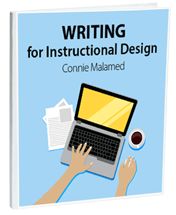 My ears perked up when I heard the word metalearning in an interview with the author of The Four Hour Chef, a book by Tim Ferriss. I was curious how metalearning—roughly defined as learning how to learn—related to a cook book.
My ears perked up when I heard the word metalearning in an interview with the author of The Four Hour Chef, a book by Tim Ferriss. I was curious how metalearning—roughly defined as learning how to learn—related to a cook book.
I wondered if the author had devised a new speed learning model based on experience that could be applied to instructional design.
As it turns out, the author learns to cook as a way to demonstrate his methods for accelerated learning. He claims his approach can overcome the dreariness of slow learning we often experience when acquiring new knowledge and skills.
This is not an academic tome, but rather an informal, conversational and circular read. If you prefer a linear narrative, you won’t find it here. The author jumps from one experience or anecdote to another, which certainly keeps things lively. Still, I did wonder whether an editor was involved in Amazon’s first foray into book publishing (rather than facilitating self-publishing).
 The DiSSS Method for Accelerating Learning
The DiSSS Method for Accelerating Learning
Over the years, Ferriss has constructed a quick-learning methodology, known as DiSSS, that he’s used to learn languages, tango dancing and other pursuits. The acronym comes from his technique: Deconstruction, Selection, Sequencing and Stakes. (The “i” just helps with acronym pronunciation and mnemonics.) Below you’ll see what each learning phase entails.
- Deconstruction is similar to chunking but it goes further. During deconstruction, you identify the minimal units that are required to become competent at a set of knowledge or skills. The author calls these “Lego blocks.”
Some deconstruction approaches that Ferriss finds helpful include: viewing the subject from a variety of perspectives, looking at what successful outliers are doing, probing the minds of experts through interviews, and finding simple commonalities in a domain that can serve as a key to accelerate learning. One important point: when interviewing experts, take in the explicit knowledge, but watch keenly for their implicit expertise (what they can not verbalize).
- Selection is based on the Pareto Principle, which states that for many events, 80% of the effects come from 20% of the causes. In terms of metalearning, identify which 20% of learning units will give you 80% of your desired outcomes. It’s a matter of distilling and simplifying to the fewest moving pieces. Selection demonstrates a concept trumpeted throughout the book—the Minimal Effective Dose (MED). This is encapsulated as, “The lowest volume, the lowest frequency, the fewest changes that get us our desired result.”
- Sequencing is the familiar act of organizing content or in this case, the learnable units, into a logical flow.
- Stakes requires you to construct consequences that will enforce sticking with the program. It’s a way to remain committed when the original fire of motivation begins to dwindle.
Second Set of Principles: CaFE
You didn’t think it was that simple, did you? There is a secondary set of principles that are part of this method. Here goes:
- Compression: Find a way to squeeze the minimal learnable units into a one-page study aid or cheat sheet. The author recommends two types: the Prescriptive One-Pager lists rules or principles that help you generate real-world examples. The Practice One-Pager lists real-world examples to practice, which helps you learn the principles indirectly.
- Frequency: Plan a study/practice schedule that provides the frequency needed to gain competency.
- Encoding: Find ways to associate the knowledge and skills with what you already know.
 10 Applications to Instructional Design
10 Applications to Instructional Design
You’ve probably found that many of the methods in the DiSSS approach are familiar to instructional design. One great difference is that DiSSS is completely learner-centered. The learner has the control, creates his or her personal program, and devises consequences for failure to follow through. For anyone with high motivation, this is an intriguing approach to try.
But what about workplace employees? The ones who take compliance training and other courses that are required for their jobs? If we could accelerate learning for the masses, imagine how appreciative they would be. Here is what I think instructional designers can borrow from this method with good results:
- Find ways to give learners more power
- Include audience members in analysis and design
- Reduce content to its minimal moving parts
- Stop and look at the goals and objectives from a variety of perspectives
- Turn content on its head; start at the end and work your way backwards
- Speak to experts who gained mastery in nontraditional ways
- Observe experts for their implicit knowledge
- Consider which 20% of skills will provide 80% of the desired outcomes
- Distill, distill, distill
- Provide study and performance support in simple one-pagers
The Four Hour Chef reminds readers that there are always setbacks and plateaus during learning, particularly accelerated learning. When people are aware that this is part of the process, it can help them maintain motivation. Do we ever talk to learners about how they learn? We should.


Hi Connie,
As a current student in Instructional Design, it is really interesting to learn about Metalearning. We can clearly see some of the well-know learning theories integrated in Ferriss’s quick learning methodology.
If we look at the DiSSS, the selection part can refer to the filter theory and the selective aspect of our own attention. The sequencing is clearly the creation of schemata, organizing the new knowledge into a meaningful structure.
Concerning the CaFE, we can obviously link it to the elaboration idea, where learners have to link the new knowledge to an existing one. Also, the fact that the more frequently you use the concept you are trying to learn, the biggest chance you have to integrate this learning in your long-term memory as rehearsal keep the long-term memory activate.
It is intriguing to see how Ferriss mixed those theories in a set of methods and principles, using the theories in a very concrete and understandable way, specially linking it to a cookbook.
The CaFE principle actually reminded me on how I used to review for my exams at the time! Making clear note cards, condensing the knowledge to key elements, reading / studying them every day, and trying to create mnemonic tips to remember that new knowledge linking it to an existing one.
The real question now would be: would this method work for any level of skills we are teaching our students?
I would totally agree for basic learning / skills. I am just wondering if Ferriss concepts are not missing an important element linked to the perception of that new learning element. Our brain will have to creating an understanding / meaning in order to properly store that knowledge, retrieve it and be able to correctly use it.
Of course, to answer this question, I have to read his book entirely.
Thanks for sharing this Connie!
Thanks for the summary Connie and the succinct summary of how the ideas could be applied. It could be relevant to practice on a project I start in February. And interesting to hear Leslie’s views too.
Hi Karen,
I believe that much of what he says in the book comes from his personal experience. I think the best thing to do if you want to get research-based information is to do a journal search for accelerated learning. I don’t think he had any other resources for this topic mentioned in his book. Thanks for participating in the conversation.
Best,
Connie
Fascinating. I’ll have to check out the book. I’ve known about DiSSS since jr. high, but CaFE? Wish that had been around when I was in school. Did he mention any resources other than his book? Would love to see some studies or data on how these are applied and their outcomes.
I’m also very curious about their application. They seem great in theory, but how does one actually apply them?
Hi Leslie,
Why don’t you tell us how you really feel. Ha ha. I don’t know much about Ferriss, but did think his metalearning approach was interesting. Anyway, thanks for your perspective. It’s good to get the full circle of opinions here.
Best,
Connie
Hi, Connie
I assume Tom’s referring to “Understanding by Design”.
Re; Ferriss… meh~~~ I can’t stand that narcissistic, grand-standing, truth-bending attention whore.
He’s the posterboy for all the marketing scumbags who’ve had ethicsadectomies and see no problem with gilding the lily to make the sale. “Do what ya gotta do to make that merchant account sing, boy!” And the easiest way is to make an emotional appeal to the big-red-easy-button inside us all.
He even lifted his 4-hour work week philosophy (which I heard one pundit comment on thus “He spends more than four hours each week promoting his book!”) more or less wholesale from A. J. Jacobs (see http://www.amazon.ca/The-Guinea-Pig-Diaries-Experiment/dp/1416599061)
Every time I hear Ferriss’s name I feel the need to have a hot shower (to wash away the snake oil).
Instead of being held up as a bastion of brilliance and determination and achievement, he needs to be exposed for the huckster that he is.
———–
In stark contrast, Connie, I find both your site and your book insightful, informative, down-to-earth… and actually based on real research.
Keep up the good work! I subscribe via RSS and I’m always happy to see your feed updated in my reader.
All the best,
Leslie
UbD?
Appears to have a lot of Gagne and UbD woven together here.